Click on images to enlarge
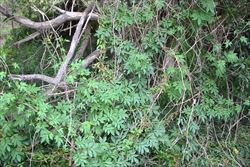
infestation (Photo: Sheldon Navie)
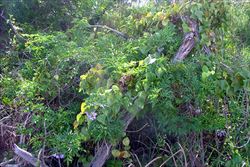
infestation (Photo: Sheldon Navie)
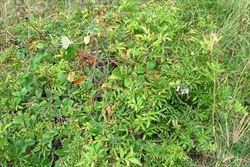
scrambling habit (Photo: Sheldon Navie)
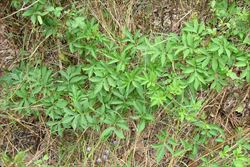
climbing habit (Photo: Sheldon Navie)
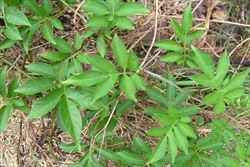
alternately-arranged leaves (Photo: Sheldon Navie)
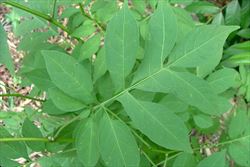
close-up of deeply-lobed leaf blade (Photo: Sheldon Navie)
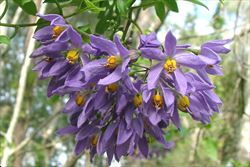
large drooping flower cluster (Photo: Sheldon Navie)
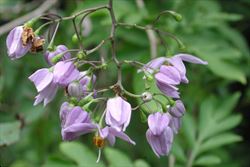
flower cluster branches with flower buds and flowers from side-on (Photo: Sheldon Navie)
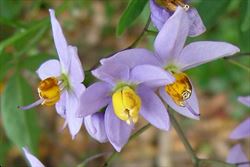
close-up of star-shaped bluish-purple flowers with yellow stamens (Photo: Sheldon Navie)
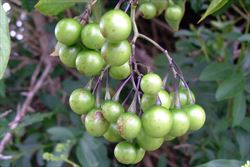
cluster of immature fruit (Photo: Sheldon Navie)
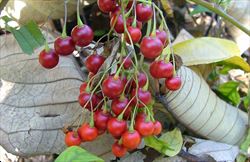
cluster of mature fruit (Photo: Sheldon Navie)
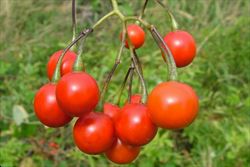
close-up of shiny red mature fruit (Photo: Sheldon Navie)
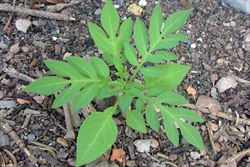
seedling (Photo: Sheldon Navie)
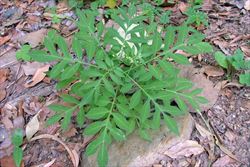
young plant (Photo: Sheldon Navie)
Scientific Name
Solanum seaforthianum Andrews
Family
Solanaceae
Common Names
blue potato vine, Brazilian night-shade, Brazilian nightshade, climbing nightshade, Italian jasmine, potato creeper, St. Vincent lilac, St. Vincent's lilac, star potato vine, vining solanum
Origin
This species is believed to be native to Mexico, Central America (i.e. Belize, Costa Rica, El Salvador, Guatemala, Honduras, Nicaragua and Panama), the Caribbean (i.e. Trinidad and Tobago), south-eastern USA (i.e. Florida) and tropical South America (i.e. Venezuela and Colombia).
Cultivation
Originally introduced as a garden ornamental, it may occasionally still be seen in cultivation.
Naturalised Distribution
Widely naturalised in the coastal districts of eastern Australia (i.e. in eastern Queensland and eastern New South Wales). Also naturalised in the coastal districts of northern Western Australia and sparingly naturalised in South Australia.
Widely naturalised overseas, including in tropical and southern Africa, eastern Asia and on some Pacific islands (e.g. Hawaii and New Caledonia).
Habitat
A common weed of untended areas with fertile soils. It is a weed of closed forests, forest margins, urban bushland, waterways (i.e. riparian areas), crops, roadsides, disturbed sites and waste areas.
Habit
A perennial vine with climbing or sprawling stems, often covering fences or shrubs, reaching up to 5 m in height.
Distinguishing Features
- a long-lived scrambling or climbing vine.
- its alternately arranged leaves have deeply-lobed margins.
- its mauve or purple star-shaped flowers (2-3 cm across) are borne in drooping clusters.
- its glossy red berries are 8-12 mm across.
Stems and Leaves
The stems are green and mostly hairless (i.e. glabrous), however there are often a few sticky (i.e. glandular) hairs on the flowering branches.
The alternately arranged leaves are borne on stalks (i.e. petioles) 0.5-6 cm long. Their leaf blades (4-13 cm long and 3-11 cm wide) are either deeply incised (i.e. pinnatisect), creating 3-9 lobes each up to 3.5-4.5 cm long and 1-2 cm wide, or appear to be once-compound (i.e. pinnate). Both leaf surfaces are green and hairless (i.e. glabrous), except for a few hairs on their margins and along the veins on either surface. The tips of their lobes may be either rounded or pointed (i.e. they have obtuse to acuminate apices).
Flowers and Fruit
The star-like flowers (2-3 cm across) are arranged in large branched clusters in the leaf forks (i.e. axils), each cluster containing 10-50 flowers. The main stalk (i.e. peduncle) of these clusters is 1-6 cm long, while each individual flower is borne on a smaller stalk (i.e. pedicel) 8-15 mm long. These flowers have five blue, violet or purple petals that are joined together at the base and have triangular tips (10-15 mm long). They also have five small green sepals (1.5-2.5 mm long), five stamens with yellow anthers (3-4 mm long), and an ovary topped with a style (6.5-8 mm long) and stigma. Flowering occurs mainly during spring and autumn.
The shiny globular berries (8-12 mm across) turn from green to bright red as they mature. They contain numerous reddish-brown to black flattened seeds (2-3 mm long).
Reproduction and Dispersal
This species reproduces mainly by seed, which are most often dispersed by birds and other animals that eat the fleshy fruit.
Environmental Impact
Brazilian nightshade (Solanum seaforthianum) is regarded as an environmental weed in New South Wales and Queensland.
Other Impacts
The fruit are poisonous to humans.
Legislation
Not declared or considered noxious by any state government authorities.
Similar Species
Brazilian nightshade (Solanum seaforthianum) can be confused with bittersweet nightshade (Solanum dulcamara), cusmayllo (Solanum radicans) and potato vine (Solanum laxum). These species can be distinguished by the following differences:
- Brazilian nightshade (Solanum seaforthianum) has three to nine-lobed leaves, mauve or purple flowers with petals 10-15 mm long, and relatively large shiny red fruit (8-12 mm across).
- bittersweet nightshade (Solanum dulcamara) has three-lobed leaves, mauve or purple flowers with petals 5-8 mm long, and relatively large shiny red fruit (6-10 mm across).
- cusmayllo (Solanum radicans) has three-lobed leaves, white flowers with petals 4-5 mm long, and relatively small yellowish-green fruit (4-6 mm across).
- potato vine (Solanum laxum) has entire or three-lobed, white flowers with petals 9-15 mm long, and relatively large dark blue to black fruit (6-9 mm across).
Note: For a more in-depth key to distinguish between all of the solanums (Solanum spp.) present in eastern Australia, see the online key to the Solanum Species of Eastern Australia at http://delta-intkey.com/solanum/index.htm.

